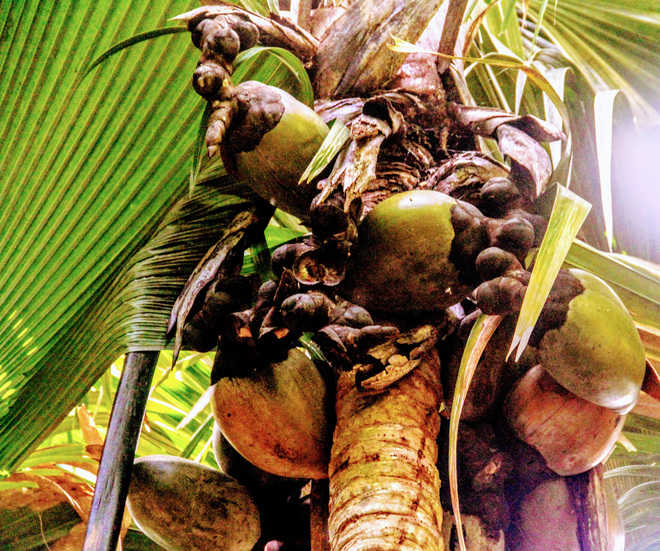Sensuous nut of the Seychelles
Kalpana Sunder
The gargantuan Coco de Mer (French for ‘coconut of the sea’) is one of the Seychelles’ most precious endemic plants. The sensuously shaped nuts have become the de facto national symbol and even the passport stamp bears its winsome image. It’s a double-lobed endemic coconut whose erotic proportions and suggestive shape have an uncanny resemblance to the bottom of a woman or her female organs, depending on how you see it! The coco de mer was originally given the botanical name Lodoicea callipyge, “callipyge” being Greek for “beautiful buttocks”.
There are a few places left on earth where you can still see this nut, so many people flock to the Seychelles to admire its unusual appearance. Valle de Maion the island of Praslin, a Unesco listed pint-sized nature reserve, a primeval playground stuffed with plants and fauna, including iridescent geckos and some of the world’s rarest birds, is home to this exotic nut.
The Vallée de Mai contains some 8,000 palms, and here the Coco de Mer is a protected species. Trekking through the exotic eco-system, one can see these special mammoth palm trees with fan-shaped leaves, which grow in both male and female versions. Each nut takes six years to reach maturity, measures up to half a meter in length and weighs up to 30 kg — roughly 10 times the weight of the average coconut! The male coco de mer palm has an enormous catkin (a drooping flower cluster) with its unmistakable phallic shape, covered in many tiny yellow star-like flowers. “Because of these unusual, erotic shapes, some people believed that the trees made passionate love on stormy nights,” explains our guide. “Don’t walk under those trees, or you may have to live forever on the island,” he quips. The forest floor is littered with the husks of nuts which have crashed to earth and exploded into coconut shrapnel.
The charismatic plant was discovered in the 19th century, but its Herculean nuts had long been known to mariners and explorers, who after months at sea found their erotic shape very stimulating and called it the love-nut! They found them washed up on beaches all over the Indian Ocean and thought that these grew in a mystical underwater garden (hence the name, which is French for ‘coconut of the sea’). Many 18th century European explorers of the Indian Ocean presented these exotic nuts to royalty who mounted them in gold and used them as drinking vessels! Victorian hero General Gordon observed that “externally the coco-de-mer represents the belly and thighs, the true seat of carnal desires”.
What interested the sailors was, of course, their naughty shape. Inside each nut is an enormous double-lobed seed that bears an uncanny resemblance to the female posterior — complete with intimate anatomical details. When the nut is forming, however, there is a milky jelly inside its cap that can be scooped out and eaten as a wobbly pudding. This is rumored to have aphrodisiac qualities, and for centuries have been used to boost male potency and fertility.
These days, these trophy seeds are highly prized by botanical collectors, and their export is strictly controlled by the Seychelles government. Prime specimens can fetch hundreds of dollars. Souvenir seeds are on sale, but they are part of a strictly controlled quota — if you buy one, make sure that it comes with a certificate that authenticates its origins.









